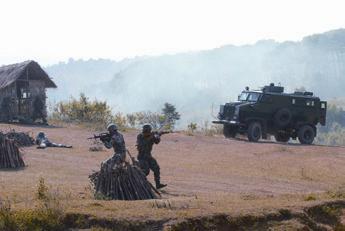Time for a New Framework
2020-07-29ByZhangJiadong
By Zhang Jiadong
In June, a serious clash between Chinese and Indian border troops at the Galwan Valley pushed the two countries to the brink of confrontation. The incident, which caused injuries and deaths, was a result of the escalation of tension in the border areas. However, it happened by chance. During a telephone conversation on July 5, Chinese Special Representative on the China-India Boundary Question, State Councilor and Foreign Minister Wang Yi and Indian Special Representative, National Security Advisor Ajit Doval reached consensus on easing the border situation.
On July 14, Chinese and Indian border troops held the fourth round of commanderlevel talks. At a press conference on July 15, Hua Chunying, a Chinese Foreign Ministry spokesperson, said the two sides achieved progress in further disengagement between border troops as well as easing the situation at the western section of the China-India boundary.
Origin of dispute
China and India are time-honored countries in Asia. The two neighbors never had disputes over territory or border until the British rule in India (1858-1947). The harsh geographical conditions in the border areas between China and India and the two countries limited abilities to rule in the past helped form a huge and natural strategic buffer zone. However, with the advent of modern nation-state and the rising governance capabilities of both countries, the strategic buffer zone gradually shrank and was minimized. Therefore, frictions and conflicts emerged. This situation will remain until a clear China-India boundary is recognized by the two sides.Although the boundary between China and India has not been completely demarcated, through border patrols, governance activities, treaties, conflicts and diplomatic efforts over the past few centuries, both countries hold a not so specific yet generally clear view on the boundary: The line as a whole should follow the alignment of the Himalayas.
In some sections, specific adjustments should be made according to governance histories and local peoples living habits. For example, in the eastern section of the ChinaIndia boundary, in principle the Himalayas serve as a buffer zone, so the watershed can be an ideal boundary between the two countries. However, considering Chinas governing history in the south of the watershed and local peoples habits of residing along valleys, the watershed is not the de facto dividing line between China and India. The line should follow the boundary alignment between the southern slope of the Himalayas and the plains on the northern bank of the Brahmaputra River. In terms of the middle and western sections of the China-India boundary, however, the historical and humanactivity basis of demarcation is different.
Different views
Today, under the consensus that no war or military confl ict should happen between China and India, territorial claims and unilateral boundary delimitations are mainly embodied in infrastructure construction, increasingly frequent patrols, as well as the management and control of the border areas. In interactions between the two governments, the dispute mainly exists in the recognition of the Line of Actual Control (LAC) and its management and control. And although the two countries have not reached a consensus on most sections of the LAC, the cognitive difference is actually much smaller than expected. In some areas, such as the Sikkim section and some mountain passes where the geographical conditions are quite clear, there are barely any differences and disputes.Both China and India are big countries. Neither of them has the ability and willingness to force the other side to accept its own claims by military means. However, there is a huge gap of understanding not only between the two countries, but also between the government, the academic circle and public opinion in each of them. Due to the increasingly democratic and transparent foreign policy-making process in modern times, the handling of the boundary issue has been affected by public opinion in both China and India. As a result, the discretion of leaders has been reduced.
In this sense, the China-India border situation carries more signif icance in terms of social psychology and domestic politics rather than that of the actual confl ict and national interest. In addition to dealing with their peers from the other side, negotiators on the boundary issue of both countries should also overcome the distraction of domestic radical views at the same time.
Consensus reached
The China-India boundary question has gone through several important stages. At each stage, greater consensus was reached between the two countries, and consequently, the gravity and sensitivity of the issue itself continued to decrease.In the first stage, China and India had no consensus on whether there was a boundary question. India gained independence in 1947. In 1949, the Peoples Republic of China was founded, and the Republic of India was offi cially established one year later. The two governments soon established formal diplomatic relations. From 1949 to 1959, both countriesborder patrols began to encounter each other in the border areas. In February 1951, the Indian army occupied Tawang in south Tibet of China, expelled all the administrative staff dispatched by the local Tibetan government, and announced that the town was placed under the administrative jurisdiction of India.
In the second stage, especially after their border confl ict in 1962, China and India began to reach agreement on the existence of the boundary question, but not on its content.
In 1960, Chinese Premier Zhou Enlai made a special trip to India. During the visit, he held talks with Indian Prime Minister Jawaharlal Nehru on the boundary issue, but no consensus was reached. The border confl ict in 1962 led to deterioration of bilateral relations as well as drastic changes in the political landscape of South Asia and even the world, affecting the developmental paths of the two countries. The improved China-Pakistan ties promoted the betterment of China-U.S. relations. The improvement of China-U.S. relations laid a diplomatic foundation for Chinas reform and opening up in the late 1970s. India took the path of getting closer to the Soviet Union which also affected its domestic economic development. The China-India boundary question produced a “butterfl y effect”that channeled the development directions of the two countries and even drove the evolution of the international political landscape.
After China and India resumed diplomatic ties in the late 1970s, they kicked off border negotiations. But they failed to agree on the content of the question. China believed that it mainly involved the eastern section of the boundary, covering about 90,000 square km; India argued that it was mainly in the western section, covering about 40,000 square km. Their claims add up to 130,000 square km, roughly the size of a medium-sized province in China or a medium-sized state in India.
In the third stage, although China and India still differed on the content of the boundary question, they reached consensus on the guiding principles for its settlement. In 1987, India made its occupied Chinese territory a state, which led to border tensions and nearly resulted in a larger-scale military conflict. The incident pushed both sides to adopt a more pragmatic approach to this issue.
Prime Minister Rajiv Gandhis trip to China in December 1988 was the fi rst visit to China by an Indian head of government in 34 years and was an ice-breaking event in bilateral relationship. The two sides signed landmark agreements on border management and control in 1993 and 1996, which stabilized the border situation. When Indian Prime Minister Atal Bihari Vajpayee visited China in 2003, the two countries resolved a series of major disputes and problems, and downgraded the territorial dispute to a boundary question. In 2005, the two countries reached an agreement on guiding principles and setting political parameters for the settlement of the boundary question, with the aim of moving toward an ultimate solution.
During this period, although many problems still existed between China and India, overall peace and stability were achieved in the border areas. On this basis, cooperation between the two countries in the realms of the economy, trade, culture, and multilateral and international affairs expanded. Both China and India benefi ted greatly from the peace and stability in the border areas.
Fostering mutual trust
In recent years, new problems have emerged in the border areas between China and India, as a result of frequent encounters of patrols and their occasional clashes.Some non-border factors are also at play, such as domestic calls in both China and India for tougher stance on the border question. Besides, with growing national strengths, their infrastructure construction and military capabilities in the border areas have been increasing. This adds to the risk of border standoffs and violent confl icts.
This situation shows that current ChinaIndia relations have lagged far behind their rising national strengths and international status. Their border management and control mechanisms are also in urgent need of transformation and upgrading.
China and India should reduce the sensitivity of the boundary question and go beyond it. Behind the boundary question and some other disputes is a lack of strategic mutual trust between the two countries. Both China and India are neighbors and major countries. They need to implement a series of trust building measures, including a strategic dialogue mechanism, a cultural exchange mechanism and a communication and mutual learning mechanism on development approaches. The setting up of these mechanisms is essential for the long-term development of bilateral relationship.
